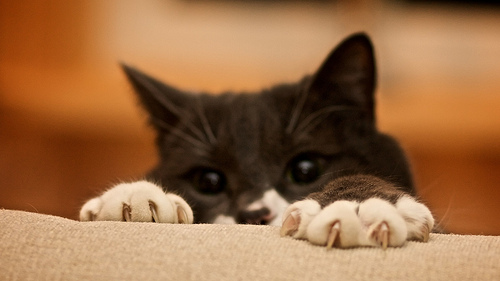Why You Shouldn’t Declaw Your Cat
Not long ago, I visited family for dinner. Pretty much as soon as I was in their home, I beelined for their cat — Hope was a new addition to the household and I hadn’t yet met her. She’s fluffy and black and white, and very compact and pretty. She’s also, as I was informed, newly declawed: “You should do it to your cats too!” Finding this out kind of put a damper on the dinner for me.
Declawing, also known as onychectomy, is the removal of a cat’s claws, usually done on the front paws. But here is something you should know about cats: their claws are closely adhered to their bone, which means that declawing is actually the removal of the last joint of your cat’s toes. Maybe you have thought of declawing as equivilant to, say, pulling out someone’s fingernails or just cutting them really really close; in fact, it’s more like amputating your fingers at the joint closest to their tips. It’s a very important distinction, and knowing what declawing really is helps people understand why it’s so wrong. As well, all surgeries involve complications, including surgical mistakes and infections; declawing is no different.
When humans suffer a serious injury to their limbs, including amputation, they generally get some time to recover and avoid using that appendage while it heals. When a cat is declawed, first comes a painful surgery, then a “recovery” that involves walking around on their now-mutilated paws. Declawing also causes long-term pain for cats by removing a key part of their feet, forcing them to walk differently. Some cats suffer emotional issues after declawing, and may start biting — their first line of defense has been removed.
Several countries, including Brazil and the UK, have made declawing illegal. The United States and Canada should too. Don’t declaw your cat!
Photo by minkuni
Comments
8 Responses to “Why You Shouldn’t Declaw Your Cat”Trackbacks
Check out what others are saying...-
[…] group is also shining a light on declawing, and why it’s not suggested. I wrote a post for Teal Cat Project — who are now selling plush kitties! — about declawing, if you want to know more.And […]















http://declawing.com/
This is a GREAT resource that goes into greater depth on this issue and the medical and emotional problems the procedure can cause our feline friends.
THANK YOU! I have always felt that declawing was a selfish and cruel act on the part of pet owners who do not take the time to train their cat or provide alternative outlets for the natural need their feline has maintain their claws.
If you can’t deal with ripped-up furniture, you really shouldn’t have a cat. I have six kitties (all with their claws intact) and sure, my stuff is all scratched up. But who cares when there’s that many balls of fur to keep me warm at night? I can’t understand why people think it’s okay to declaw.
My first cat was declawed when I was still in my mother. After she passed, my sister dumped her cats on me because she didn’t want them. I didn’t know declawing would be so painful for them; if I did, I would never have done it. My baby, Mimi, had an infected claw afterwards and still occasionally walks with a limp. I will never declaw another cat again, and I regret it terribly.
Get Soft Claws! Gel caps you put on your cat’s nails and they work awesome. They prevent your furniture from getting destroyed and your cat is not bothered or in pain. And you can get any color you want so your kitty can be glamorous! 🙂
We have those for our newest cats. Sadly, one of them had the problem of his claws + caps growing into his pads (he’s got big claws) ’cause his claws weren’t shedding properly, so now we have to just clip his claws.
If you’re going to put caps on your kitties and they’ve got big digits, make sure they have something good to scratch on (a closed-loop rug worked for this problem kitty before we got rid of it) so they don’t end up having to go to vet to get their cap removed (it cost us a lot).
I am an animal intuitive and I have had several cat clients who had HUGE emotional issues after being declawed. Please do not do this to your cats – as others have said, if you can’t deal with possible scratched stuff then don’t have cats. We have six – none of whom scratch our furniture as we trained them positively to use their provided scratching posts.